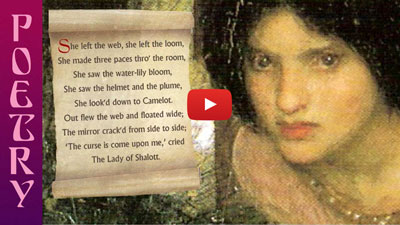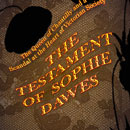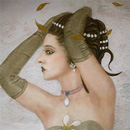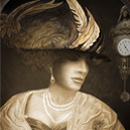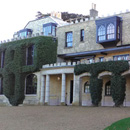Camelot, Lancelot - the story of the mysterious Lady in the Tower
Transcript in four parts
Part I.
On either side the river lie
Long fields of barley and of rye,
That clothe the wold and meet the sky;
And thro' the field the road runs by
To many-tower'd Camelot;
And up and down the people go,
Gazing where the lilies blow
Round an island there below,
The island of Shalott.
Willows whiten, aspens quiver,
Little breezes dusk and shiver
Thro' the wave that runs for ever
By the island in the river
Flowing down to Camelot.
Four gray walls, and four gray towers,
Overlook a space of flowers,
And the silent isle imbowers
The Lady of Shalott.
By the margin, willow-veil'd
Slide the heavy barges trail'd
By slow horses; and unhail'd
The shallop flitteth silken-sail'd
Skimming down to Camelot:
But who hath seen her wave her hand?
Or at the casement seen her stand?
Or is she known in all the land,
The Lady of Shalott?
Only reapers, reaping early
In among the bearded barley,
Hear a song that echoes cheerly
From the river winding clearly,
Down to tower'd Camelot:
And by the moon the reaper weary,
Piling sheaves in uplands airy,
Listening, whispers "'Tis the fairy
Lady of Shalott."
Part II.
There she weaves by night and day
A magic web with colours gay.
She has heard a whisper say,
A curse is on her if she stay
To look down to Camelot.
She knows not what the curse may be,
And so she weaveth steadily,
And little other care hath she,
The Lady of Shalott.
And moving thro' a mirror clear
That hangs before her all the year,
Shadows of the world appear.
There she sees the highway near
Winding down to Camelot:
There the river eddy whirls,
And there the surly village-churls,
And the red cloaks of market girls,
Pass onward from Shalott.
Sometimes a troop of damsels glad,
An abbot on an ambling pad,
Sometimes a curly shepherd-lad,
Or long-hair'd page in crimson clad,
Goes by to tower'd Camelot;
And sometimes thro' the mirror blue
The knights come riding two and two:
She hath no loyal knight and true,
The Lady of Shalott.
But in her web she still delights
To weave the mirror's magic sights,
For often thro' the silent nights
A funeral, with plumes and lights
And music, went to Camelot:
Or when the moon was overhead,
Came two young lovers lately wed;
"I am half-sick of shadows," said
The Lady of Shalott.
Part III.
A bow-shot from her bower-eaves,
He rode between the barley-sheaves,
The sun came dazzling thro' the leaves,
And flamed upon the brazen greaves
Of bold Sir Lancelot.
A redcross knight for ever kneel'd
To a lady in his shield,
That sparkled on the yellow field,
Beside remote Shalott.
The gemmy bridle glitter'd free,
Like to some branch of stars we see
Hung in the golden Galaxy.
The bridle-bells rang merrily
As he rode down to Camelot:
And from his blazon'd baldric slung
A mighty silver bugle hung,
And as he rode his armour rung,
Beside remote Shalott.
All in the blue unclouded weather
Thick-jewell'd shone the saddle-leather,
The helmet and the helmet-feather
Burn'd like one burning flame together,
As he rode down to Camelot.
As often thro' the purple night,
Below the starry clusters bright,
Some bearded meteor, trailing light,
Moves over still Shalott.
His broad clear brow in sunlight glow'd;
On burnish'd hooves his war-horse trode;
From underneath his helmet flow'd
His coal-black curls as on he rode,
As he rode down to Camelot.
From the bank and from the river
He flash'd into the crystal mirror,
"Tirra lirra," by the river
Sang Sir Lancelot.
She left the web, she left the loom,
She made three paces thro' the room,
She saw the water-lily bloom,
She saw the helmet and the plume,
She look'd down to Camelot.
Out flew the web and floated wide;
The mirror crack'd from side to side;
"The curse is come upon me," cried
The Lady of Shalott.
Part IV.
In the stormy east-wind straining,
The pale-yellow woods were waning,
The broad stream in his banks complaining,
Heavily the low sky raining
Over tower'd Camelot;
Down she came and found a boat
Beneath a willow left afloat,
And round about the prow she wrote
The Lady of Shalott.
And down the river's dim expanse –
Like some bold seër in a trance,
Seeing all his own mischance –
With a glassy countenance
Did she look to Camelot.
And at the closing of the day
She loosed the chain, and down she lay;
The broad stream bore her far away,
The Lady of Shalott.
Lying, robed in snowy white
That loosely flew to left and right –
The leaves upon her falling light –
Thro' the noises of the night
She floated down to Camelot:
And as the boat-head wound along
The willowy hills and fields among,
They heard her singing her last song,
The Lady of Shalott.
Heard a carol, mournful, holy,
Chanted loudly, chanted lowly,
Till her blood was frozen slowly,
And her eyes were darken'd wholly,
Turn'd to tower'd Camelot;
For ere she reach'd upon the tide
The first house by the water-side,
Singing in her song she died,
The Lady of Shalott.
Under tower and balcony,
By garden-wall and gallery,
A gleaming shape she floated by,
A corse between the houses high,
Silent into Camelot.
Out upon the wharfs they came,
Knight and burgher, lord and dame,
And round the prow they read her name,
The Lady of Shalott.
Who is this? and what is here?
And in the lighted palace near
Died the sound of royal cheer;
And they cross'd themselves for fear,
All the knights at Camelot:
But Lancelot mused a little space;
He said, "She has a lovely face;
God in his mercy lend her grace,
The Lady of Shalott."
Background - a brief biography of the poet Alfred, Lord Tennyson
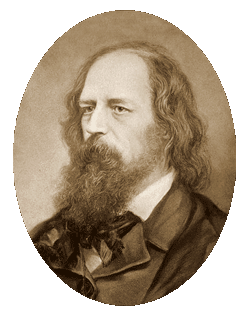
● Tennyson was born in 1809 in Lincolnshire, England, the 4th of 12 children.
● He began his university education at Trinity College, Cambridge in 1827 where he met Arthur Hallam who was to become his great friend. Hallam became engaged to Tennyson’s sister, and the two men toured Europe together in 1830 and again in 1832. Hallam’s sudden death in 1833 had a profound and lasting effect on Tennyson.
● In 1836, he became engaged to Emily Sellwood, and despite some steadfast resistance from her family, they married eventually in 1850 - a pivotal year, in which Tennyson’s poem In Memoriam was discovered and praised by Queen Victoria who, some years later, was to find its lines especially comforting following the death of the Prince Consort). Tennyson’s fame was assured, and he was appointed Poet Laureate.
● He began his university education at Trinity College, Cambridge in 1827 where he met Arthur Hallam who was to become his great friend. Hallam became engaged to Tennyson’s sister, and the two men toured Europe together in 1830 and again in 1832. Hallam’s sudden death in 1833 had a profound and lasting effect on Tennyson.
● In 1836, he became engaged to Emily Sellwood, and despite some steadfast resistance from her family, they married eventually in 1850 - a pivotal year, in which Tennyson’s poem In Memoriam was discovered and praised by Queen Victoria who, some years later, was to find its lines especially comforting following the death of the Prince Consort). Tennyson’s fame was assured, and he was appointed Poet Laureate.
● The Tennysons moved to a new family home, Farringford House on the Isle of Wight, in 1853 where they remained for many years, though sadly one of his two children, Lionel, died young.
● The popularity of his work extended to the Pre-Raphaelite circle of painters and poets who made extensive use of many of his classical and medieval themes - collectively establishing a style of creative endeavour that sustained much of the Victorian Gothic culture of the 19th century.
● Tennyson passed away in 1892 and is buried in Westminster Abbey.
● The popularity of his work extended to the Pre-Raphaelite circle of painters and poets who made extensive use of many of his classical and medieval themes - collectively establishing a style of creative endeavour that sustained much of the Victorian Gothic culture of the 19th century.
● Tennyson passed away in 1892 and is buried in Westminster Abbey.
The Lady of Shalott - insights, themes and ideas for interpretation
● The poem, which exerted such an inspirational force on the artists of the 19th-century Pre-Raphaelite movement, is an amazing blend of classicism, Victorian Gothic and ancient Medieval themes. On the surface, it seem an improbable tale: a story of a woman confined to a tower on an island in a river. Here, due to a curse from some unspecified source, she is forbidden from viewing the outside world though anything other than a mirror, which she glances at from time to time while weaving at a loom.
● With more than a nod to the philosopher Plato’s allegory of The Cave (360 BC), the poem it is clearly not intended to describe reality, but rather to identify and comment on the limitations of ordinary human perception.
In Plato’s tale, a number of prisoners have been chained since birth to the floor inside of a dark cave. Their existence is one in which they perceive only shadows of the world on a wall in front of them. The source of light that casts the shadows is that of a fire behind, which, due to their shackles, the captives can never turn to see directly. With time, as they grow up, they come to mistake the shadows on the wall for reality itself.
● The lyrical story of the poem here is, likewise, that of someone imprisoned - in this case within a medieval tower, and it is a mirror that is the source of perception. The classical, neo-Platonic reference is further underlined by the description of ‘shadows of the world’ appearing in the glass rather than reflections, as one would normally expect from the description of things seen in a mirror. Tennyson deliberately chooses shadows, not reflections.
● Only when the lady leaves her loom and is moved to look directly at the Grail knight, Lancelot, as he rides past one day, does she become liberated from the world of shadows. Lancelot is described as a being of light, glowing, like the sun.
● Having ‘seen the light,’ the lady’s previous source of shadowy, second-hand knowledge is destroyed. The mirror cracks; the curse descends and nothing will ever be the same again.
● About to be born again in the death of her old self, she surrenders to the inevitable, and sets herself on a final journey to Camelot. There, she receives a blessing from Lancelot, the knight of the Grail - that very same source of light that has set her free.
● The poem's dramatic and Romantic story gave rise to numerous works of art among the painters of the Pre-Raphaelite and later Victorian Aesthetic movement, including works by Dante Gabriel Rossetti, John Willian Waterhouse, William Holman Hunt, Walter Crane, John Atkinson Grimshaw and many others.
● It is a message of personal enlightenment that has never been more relevant than today. The ‘shadows’ of the world in the 21st century now appear on screens of various sizes and, just like the unfortunate woman herself, we are beguiled by them. The poem urges us to think for ourselves, to look up and escape from all those who seek to limit our perceptions – which are boundless.
● With more than a nod to the philosopher Plato’s allegory of The Cave (360 BC), the poem it is clearly not intended to describe reality, but rather to identify and comment on the limitations of ordinary human perception.
In Plato’s tale, a number of prisoners have been chained since birth to the floor inside of a dark cave. Their existence is one in which they perceive only shadows of the world on a wall in front of them. The source of light that casts the shadows is that of a fire behind, which, due to their shackles, the captives can never turn to see directly. With time, as they grow up, they come to mistake the shadows on the wall for reality itself.
● The lyrical story of the poem here is, likewise, that of someone imprisoned - in this case within a medieval tower, and it is a mirror that is the source of perception. The classical, neo-Platonic reference is further underlined by the description of ‘shadows of the world’ appearing in the glass rather than reflections, as one would normally expect from the description of things seen in a mirror. Tennyson deliberately chooses shadows, not reflections.
● Only when the lady leaves her loom and is moved to look directly at the Grail knight, Lancelot, as he rides past one day, does she become liberated from the world of shadows. Lancelot is described as a being of light, glowing, like the sun.
● Having ‘seen the light,’ the lady’s previous source of shadowy, second-hand knowledge is destroyed. The mirror cracks; the curse descends and nothing will ever be the same again.
● About to be born again in the death of her old self, she surrenders to the inevitable, and sets herself on a final journey to Camelot. There, she receives a blessing from Lancelot, the knight of the Grail - that very same source of light that has set her free.
● The poem's dramatic and Romantic story gave rise to numerous works of art among the painters of the Pre-Raphaelite and later Victorian Aesthetic movement, including works by Dante Gabriel Rossetti, John Willian Waterhouse, William Holman Hunt, Walter Crane, John Atkinson Grimshaw and many others.
● It is a message of personal enlightenment that has never been more relevant than today. The ‘shadows’ of the world in the 21st century now appear on screens of various sizes and, just like the unfortunate woman herself, we are beguiled by them. The poem urges us to think for ourselves, to look up and escape from all those who seek to limit our perceptions – which are boundless.
Technical info’
Type of Poem =
a ballad (a poem which usually tells a story about a person or place). This piece consists of four parts. The first two parts have four stanzas each. The 3rd part has five, and the 4th has 6 - equalling 19 stanzas in total. Each one contains 9 lines.Rhyme Scheme =
AAAA B CCC B - which is the pattern for the first stanza - all the others following the same sequence.Meter =
tetrameter (four pairs of syllables per line, making 8 per line) and with the stresses varying from iambic tetrameter (first syllable unstressed, seconded stressed) to trochaic tetrameter (first syllable stressed, second unstressed). Exceptions occur in lines 5 and 9 of each stanza, where truncations occur.Victorian Gothic
Historical Novel
Historical Novel
Tennyson

